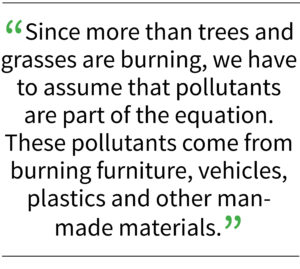Pollutants in the air come from burning furniture, vehicles, plastics, and other man-made materials
By Kate Russell

Kate Russell
If a global pandemic wasn’t a problem enough, we now find ourselves surrounded by wildfires, creating ominous red and orange skies.
Why does the sky look like that and what does it mean for Morgan Hill gardens?
The smoke particles from the fires allow sunlight’s longer wavelength colors like red and orange to get through while blocking the shorter wavelengths of yellow, blue and green. But we don’t need Spare The Air alerts to tell us something is wrong. We can see it. But what do these conditions do to plants? Is it harmful or helpful? You might be surprised to learn that it can be both.
We all know that shade protects plants from sunscald. The smoke and particles currently flying around are providing similar protection for outdoor plants. Unless the smoke is thick, rather than blocking sunlight, these particles diffuse sunlight, bouncing it around in more directions. This provides sunlight for photosynthesis to occur in places where it normally would not.
Many of the particles found in wildfire smoke are carbon-based and there’s more carbon dioxide in the air during fire season. Plants use carbon for food and carbon dioxide in photosynthesis. To that degree, the fires and smoke are good for plants, but that’s probably where the benefits end.
Since more than trees and grasses are burning, we have to assume that pollutants are also part of the equation. These pollutants come from burning furniture, vehicles, plastics, and other man-made materials.
 Research has shown that many substances found in wildfire smoke can cause problems for plants. These chemicals can destroy chlorophyll, reduce photosynthesis, and interfere with other processes. Fires and smoke can also result in conditions that cause plants to close their stomata. Stomata are, in essence, breathing holes. Fires also increase ground level ozone. Ozone is bad for plants. Once ozone enters a plant, it is transformed into a substance that breaks down cell membranes. Symptoms of exposure to high concentrations of ozone include bronzing, flecking, reddening, and stippling.
Research has shown that many substances found in wildfire smoke can cause problems for plants. These chemicals can destroy chlorophyll, reduce photosynthesis, and interfere with other processes. Fires and smoke can also result in conditions that cause plants to close their stomata. Stomata are, in essence, breathing holes. Fires also increase ground level ozone. Ozone is bad for plants. Once ozone enters a plant, it is transformed into a substance that breaks down cell membranes. Symptoms of exposure to high concentrations of ozone include bronzing, flecking, reddening, and stippling.
Further exposure can lead to chlorosis, early senescence, and necrosis. If all that weren’t bad enough, stressed plants are more susceptible to pest infestations and infections.
The best thing you can do for your plants right now is to rinse them off with a garden hose, monitor them closely, keep them properly irrigated, and avoid the use of fertilizer until things get back to normal.
Keep in mind that most of the pollutants and particles will end up on the ground. Irrigation and rainwater can push those chemicals into the soil where they may be absorbed by plants. It’s a good idea to have your soil tested after a major fire episode to check for contaminants. It’s also a good idea to wash your produce more thoroughly than normal.
Just in case.
As for us gardeners, just like our plants, we need to stay clean, hydrated, and protected.








